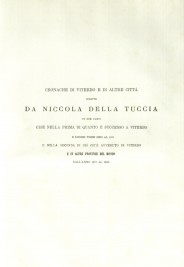
The Holy Door at Saint John’s in the fifteenth century
Niccolò della Tuccia, who however seems to be reporting information he had heard indirectly, was the first to mention a “door”, although fifteenth-century chronicles already mentioned the opening of a special door in the Basilica of the Lateran in the fifteenth century. However, the information in question is contradictory, so we cannot be certain that the door existed or that it had any symbolic value.
Niccolò della Tuccia, Cronache di Viterbo e di altre città..., in: Cronache e statuti della città di Viterbo pubblicati ed illustrati da Ignazio Campi, Firenze 1872